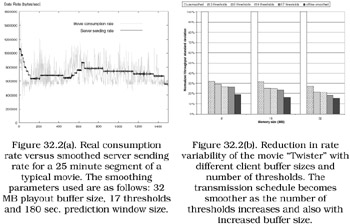3. Variable Bitrate Smoothing
3. Variable Bitrate Smoothing
Many popular compression algorithms use variable bitrate (VBR) media stream encoding. VBR algorithms allocate more bits per time to complex parts of a stream and less bits to simple parts to keep the visual and aural quality at near constant levels. For example, an action sequence in a movie may require more bits per second than the credits that are displayed at the end. As a result, different transmission rates may be required over the length of a media stream to avoid starvation or overflow of the client buffer. As a contradictory requirement we would like to minimize the variability of the data transmitted through a network. High variability produces uneven resource utilization and may lead to congestion and exacerbate display disruptions.
To achieve scalability and high resource utilization, both at the server and client sides, it was our goal to reduce the variability of the transmitted data. We designed and implemented a novel technique that adjusts the multimedia traffic based on an end-to-end rate control mechanism in conjunction with an intelligent buffer management scheme. Unlike previous studies [21, 14], we consider multiple signaling thresholds and adaptively predict the future bandwidth requirements. With this Multi-Threshold Flow Control (MTFC) scheme, VBR streams are accommodated without a priori knowledge of the stream bitrate. Furthermore, because the MTFC algorithm encompasses server, network and clients, it adapts itself to changing network conditions. Display disruptions are minimized even with few client resources (e.g., a small buffer size).
3.1 Approach
MTFC is an adaptive technique that works in a real-world, dynamic environment with minimal prior knowledge of the multimedia streams needing to be served. It is designed to satisfy the following desirable characteristics:
-
Online operation: This is required for live streaming and it is also desirable for stored streams.
-
Content independence: An algorithm that is not tied to any particular encoding technique will continue to work when new compression algorithms are introduced.
-
Minimizing feedback control signaling: The overhead of online signaling should be negligible to compete with offline methods that do not need any signaling.
-
Rate smoothing: The peak data rate as well as the number of rate changes should be lowered compared with the original, unsmoothed stream. This will improve network transmissions and resource utilization.
The MTFC algorithm incorporates the following: 1) a multi-threshold client buffer model, 2) a consumption prediction model and 3) a rate change ∆r computation algorithm. The three components work together as follows. The client playout buffer incorporates multiple thresholds. When the data level sufficiently deviates from the buffer midpoint, a correction message is sent to the server to adjust the sending rate. The sending rate change ∆r is computed based on the value of the threshold that was crossed and the estimated data consumption in the near future. MTFC is parameterized in many different ways. For example, thresholds can either be equi-spaced or not (e.g., exponential) and we have tested several consumption prediction algorithms. The full details of the MTFC can be found in [37].
3.2 Performance Evaluation
MTFC is fully implemented in our architecture and we have tested its effectiveness in both LAN and WAN environments. The following is a subset of the test results. Figure 32.2(a) visually illustrates the effectiveness of our MTFC algorithm. Shown are the unsmoothed and the smoothed transmission rate of the movie "Twister" with a playout buffer size B = 32 MB, m = 17 thresholds and a consumption prediction window size wpred = 180 seconds. The variability is clearly reduced as well as the peak rate.

Figure 32.2: Smoothing effectiveness of the MTFC algorithm with the movie "Twister."
To objectively quantify the effectiveness of our technique with many different parameter sets, we measured the standard deviation of the transmission schedule. Figure 32.2(b) presents the reduction in standard deviation achieved by MTFC, across client buffer sizes ranging from 8 MB to 32 MB and with the number of thresholds ranging from 3 to 17. In all cases, the standard deviation is reduced substantially, by 28–42% for an 8 MB client buffer, 30–47% for a 16 MB client buffer, and 38–59% for a 32 MB client buffer. This figure illustrates what is intuitively clear: an increase in the client buffer size yields smoother traffic. More importantly, it also shows that a higher number of thresholds results in smoother traffic.
EAN: 2147483647
Pages: 393